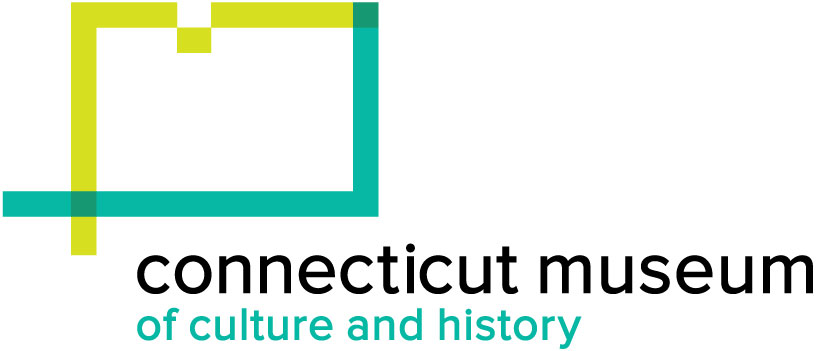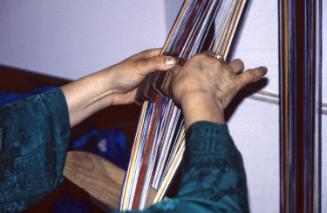Tibetan Weavers and Taíno Percussion Instruments
SubjectPortrait of
Melanio Gonzalez
(born 1951)
SubjectPortrait of
Tsering Yangzom
(Tibetan)
SubjectPortrait of
Dadon Dawa Dolma
(Tibetan, born 1968)
SubjectPortrait of
Phurbu Kyipa
(Tibetan)
Date1997
Mediumslides
ClassificationsGraphics
Credit LineConnecticut Cultural Heritage Arts Program collections
CopyrightIn Copyright
Object number2015.196.245.1-.12
Description2015.196.245.1-.9 are slides of Tibetan weavers in New Haven on June 28, 1997.
2015.196.245.10-.12 are slides of the Puerto Rican Taíno exhibit (Herencia Taina) with Melanio Gonzalez.
(.1) Tibetan weavers demonstrating at Kebabians Carpet House.
(.2) Tibetan weaver Tsering Yangzom demonstrating at the International Festival of Arts and Ideas.
(.3) Tibetan weaver Dawa.
(.4) Tsering Yangzom and Phurbu Kyipa weaving at Kebabians Carpet House.
(.5) A Tibetan weaver is preparing the warp.
(.6) Tibetan weavers demonstrating at the International Festival of Arts and Ideas.
(.7) Tibetan weaver Tsering Lhamo, the aunt of weaver Tsultim Lama, is using a beater on the loom.
(.8) Tsering Yangzom is demonstrating tablet weaving at the International Festival of Arts and Ideas.
(.9) Dawa is demonstrating at the International Festival of Arts and Ideas.
(.10-.12) Melanio Gonzalez is demonstrating Puerto Rican Taino percussion instruments that he made during the 1997 Herencia Taina exhibit at Institute for Community Research.
NotesSubject Note for 2015.196.245.1-.9: John Kebabian of Kebabians Carpet House in New Haven, who had previously built a loom for a Tibetan weaver in New York, built a loom in his shop for carpet weaver Phurbu Kyipa, whose carpet was displayed in the "Auspicious Signs: Tibetan Arts in New England" exhibit in 1996. After the loom was built, Phurbu Kyipa from New Hampshire and three other weavers living in Connecticut – Tsultim Lama and Tsering Yangzom, and Dawa traveled to New Haven on June 14, 1997, with CCHAP Director and exhibit curator Lynne Williamson to warp the loom and start weaving on it. They also presented a demonstration at Kebabians and then outside on the Green on June 28 during the International Festival of Arts and Ideas in New Haven. At the outdoor event, weavers present included Tsering Yangzom, Phurbu Kyipa, Dawa, and another Tibetan woman.2015.196.245.10-.12 are slides of the Puerto Rican Taíno exhibit (Herencia Taina) with Melanio Gonzalez.
(.1) Tibetan weavers demonstrating at Kebabians Carpet House.
(.2) Tibetan weaver Tsering Yangzom demonstrating at the International Festival of Arts and Ideas.
(.3) Tibetan weaver Dawa.
(.4) Tsering Yangzom and Phurbu Kyipa weaving at Kebabians Carpet House.
(.5) A Tibetan weaver is preparing the warp.
(.6) Tibetan weavers demonstrating at the International Festival of Arts and Ideas.
(.7) Tibetan weaver Tsering Lhamo, the aunt of weaver Tsultim Lama, is using a beater on the loom.
(.8) Tsering Yangzom is demonstrating tablet weaving at the International Festival of Arts and Ideas.
(.9) Dawa is demonstrating at the International Festival of Arts and Ideas.
(.10-.12) Melanio Gonzalez is demonstrating Puerto Rican Taino percussion instruments that he made during the 1997 Herencia Taina exhibit at Institute for Community Research.
Tibetan carpets are woven by hand on a large frame loom. Traditionally, carpets are used to cover seats and beds, as wall hangings, and in monasteries as cushions, back rests, drum covers, or pillar covers. Tibetan carpets are made from three kinds of sheep's wool: chemically dyed Indian wool, naturally and chemically dyed Australian wool which is softer, and naturally dyed coarser Tibetan wool.
Biographical Note: Tsering Yangzom weaves belts with traditional designs on her backstrap loom as well as wool material for blankets, aprons, jackets, and bags on a larger loom. Her skill, learned from her mother in a remote village on the Nepal/Tibet border, is one traditionally shared by rural women. When she was seven years old Tsering Yangzom's family fled Tibet, settling in a remote Nepali village near the Tibetan border. It was difficult for Tibetan exiles to make a new life there as they were foreigners, bringing few possessions and little money with them. One way for families to generate both income and necessary household furnishings was to utilize women's traditional weaving skills. Tseyang's mother made blankets, bags, warm coats - chupa, and married women's traditional striped aprons - pang-dhen out of cloth she wove from dyed sheeps' wool, as well as small carpets and seat coverings. These were also sold in shops in the town.
Tseyang and her younger sister were taught to card and spin yarn from sheeps' wool, and weave it into cloth, a common practice for Tibetan women. In school all children learned to make the patterned belts that Tibetans tie around their chupa. Later Tseyang worked in a factory handweaving Tibetan carpets as this industry grew in Nepal.
Tseyang brought to her new home in Old Saybrook the traditional narrow loom she used to weave belts, although she could not bring with her the larger loom for cloth. Belts are made on a thak-ti, a tension loom which uses a process called tablet weaving to create quite complex designs on belts up to six inches wide. Pierced thin leather cards, or tablets, are strung side by side onto individual vertical warp threads. Tension on the warp threads is provided as the weaver pulls against the threads attached to a backstrap tied around her waist. As she pulls, she rotates all the tablets at once, an action which moves some warp threads up and some down to create a space between them, in the manner of a heddle. She passes a thread horizontally through this space in a weaving motion, pushes it down tightly with a wooden beater, then rotates the tablets again to lift another set of warp threads before weaving again. The pattern is determined by the number of tablets strung onto certain colors of warp threads. In another photograph of this loom Tseyang has seven tablets strung with dark threads on either side, with twenty-four white thread cards between them, to make a simple two-color belt. Tseyang moved to Torrington, Connecticut then New York City to live.
Biographical Note: Phurbu Kyipa can weave a 6 x 3 foot carpet in twenty days. She learned this skill from senior weavers in the Tibetan Women's Association in Dheradun, India, where she settled after fleeing with her family from Tibet after 1959. She immigrated to New Hampshire in 1993 and her family followed a few years later. Although Phurbu made her living in India from carpet weaving, she is presently working in a medical services company in New Hampshire. Her carpet made from Australian wool, featuring round mandala-like motifs within geometric borders, was loaned to the 1996 "Auspicious Signs: Tibetan Arts in New England" exhibit by Sonam Lama.
Biographical Note: Tsultim Lama is a skilled designer and weaver of carpets in the traditional Tibetan hand-knotted style who learned her craft while living in Nepal. In addition to her weaving skills, Tsultim and her husband own and manage two restaurants in Connecticut.
Subject Note for 2015.196.245.10-.12: "Herencia Taina: Legacy and Life" was an exhibit and related programs examining the history of Puerto Rico's indigenous people, the Taino through contemporary art expressions and interpretations, on view May 3-November 30, 1997 at the Institute for Community Research.
ICR's Connecticut Cultural Heritage Arts Program, in conjunction with project scholar Ruth Glasser and designer Ricardo Mulero, planned an exhibit, workshops, and concert to present a wide range of arts practiced by musicians and visual artists who are inspired by Taino heritage. Participating artists included Imna Arroyo (Eastern Connecticut State University), Graciela Quiñones (West Hartford), Mel Gonzalez (Meriden), and Robert Borrero (New York), who created contemporary interpretations and folk art works illustrating Taino heritage, such as musical instruments, gourd carvings, paintings, and textile art, as well as interpretive information for these. Their works were juxtaposed with Taino artifacts from archaeological collections, along with photographs and posters from the continuing indigenous festival held in Jayuya, Puerto Rico, to show the strong influence that Taino culture still holds for Puerto Ricans. The exhibit project also presented several public events including a concert, a workshop for teachers, and a roundtable discussion. An illustrated brochure in both English and Spanish was produced. The project was supported by the Connecticut Humanities Council, the Connecticut Commission on the Arts, the Edward C. and Ann T. Roberts Foundation, the Greater Hartford Arts Council, and the Institute for Community Research.
The heritage of the Taino Indians is often proudly proclaimed by Puerto Ricans as one of the three strands of their multi-racial society. What that heritage consists of, how much of it has survived, and its relative importance in the overall culture of the island has been a hotly debated topic for centuries. The Tainos, indigenous people living in Puerto Rico when colonists arrived in the late 15th century, provide an example of the politics and complexities of interpreting a culture which has only a small present-day community and no living language, but is both remembered from the recent past and still represented in blood lines, place names, some everyday practices, and spiritual and political inspiration.
Recreated musical instruments made by members of the group Cacibajagua showed how contemporary Puerto Ricans have been both adopting Taino heritage and basing their work on serious study of archaeology and indigenous materials. Cacibajagua demonstrated their music at a concert on May 1, 1997, at Charter Oak Cultural Center in Hartford.
Biographical Note: Melanio Gonzalez is a Meriden-based visual artist and musician with Taino family roots who has conducted research on Taino history with an emphasis on musical forms. He makes and plays musical instruments indigenous to the Caribbean, such as the mayahuacan (log drum), maracas, drum sticks, seed rattles, cane flutes, and tree branch trumpets. Mel also makes masks and other ceremonial objects. He is a founding member and performer with the group Cacibajagua (the mythical cave from which all Taino emerged), which bases its presentations on members' research.
He has compiled an impressive body of information on Taino history and archaeology, difficult to do because of controversy and secrecy surrounding the topic of Taino identity. Mel has explored sources beyond the written, academic, and accepted, uncovering oral histories from his own family and the people living quiet, traditional lives in the central mountains of the island. He has presented his research into the Taino people of Puerto Rico at the American Indian Archaeological Institute in Washington, Connecticut, and at El Museo del Barrio's NYC exhibit on Taino archaeology.
Mel makes Taino regalia and musical instruments, decorative carvings, and sand paintings. His creations are technically excellent because he spends time making them perfect both in background research on the form, and in execution. Mel has developed effective presentations on Taino art and culture for a variety of audiences. During the Herencia Taína exhibit at ICR, Mel served as a project advisor and presented music workshops to school groups and other audiences during the exhibit. He also participated in the panel discussion "Taino Culture in Contemporary Life: Revival or Reaffirmation?" His music group Cacibajagua presented a concert on May 1, 1997 at Charter Oak Cultural Center as part of the Connecticut Heritage Music Series, a collaboration between the Charter Oak Cultural Center and CCHAP from September 1996 through June 1997. In 1999, he again served as a project advisor for "Mano a Mano: Puerto Rican Traditional Arts from Island to City" at ICR.
Mel loaned the following objects to the Herencia Taina exhibit: big log drum, two smaller drums, gourd tobacco holder, pirana jaw necklace, caiman tooth necklace, cane flute, ceremonial spatula, cohoba pipe, two gourd ladles, bohio model, bark branch trumpet, war club, chair, mask, maracas, and a nut rattle. He has donated two pieces to the CCHAP collection at the Connecticut Historical Society: a drawing of a native man (2015.199.1) and a painting of a Taino spirit being on slate (2015.199.2).
Additional audio, video, and/or photographic materials exist in the archive relating to these artists.
Cataloging Note: This project was made possible in part by the Institute of Museum and Library Services MA-245929-OMS-20.
Status
Not on viewHaris Gusta Guya
2011 November 4

























